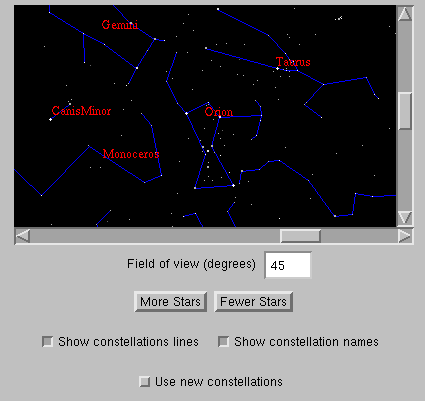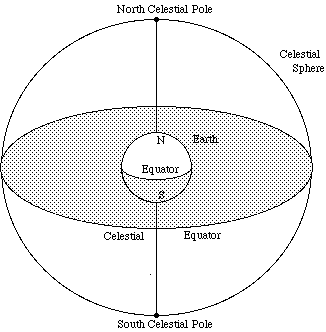
This is a picture of what the applet looks on a Silicon Graphics workstation
Problems viewing the applet? Look at the troubleshooting section below.

You can turn the Constellation lines and/or names on or off with the buttons below the Star Window. Turning them off makes the program run a little bit faster. You can also select the patterns by which the constellations are connected. The standard set (the one that is used when the program starts up) is the one that you will see in most star catalogs. the so-called "New" constellations patterns were made up by H.A. Rey in the 1940's. They are intended to be more logical than the standard ones, even if they omit some stars.
You can make the program display a larger or smaller number of stars by pressing the buttons marked "More stars" and "Fewer stars." Displaying fewer stars makes the program run faster.
If you hold down the mouse button on any part of the Star Window, the program prints out the RA and Dec coordinates (see below) for that point on the sky.
Declination is very much like latitude on the Earth. A Dec
of 0 degreed points to the "Celestial Equator" just like a latitude of
0 is at the Equator. Similarly, a Dec of +90 degrees points to the
"North Celestial Pole" and -90 degrees points to the "South Celestial
Pole." The word Celestial is used to distinguish between, for
example, the North Pole in the sky and the North Pole on the Earth.
The Celestial Poles lie directly above the Poles on the Earth, so if
you were at the North Pole, the North Celestial Pole would be directly
overhead. Keep in mind that the places on the so-called Celestial
Sphere are directions not positions . Two stars
that appear next to each other on the sky may actually be very far
apart in reality if one is much further away from the other.
Right Ascension is similar to longitude on the Earth, however
it is numbered differently. Longitude starts at 0 degrees at the
Prime Meridian and goes to 180 degree East or 180 degrees West. Since
the Earth is a sphere, 180 E is equal to 180 W. Right Ascension, on
the other hand, is measured in hours instead of degrees, for historical
reasons. It starts at 0 hours at the "First Point of Aries" and goes
all the way around to 24 hours which is at the same place as 0 hours.
So a star that has an RA of 12 hours is on the opposite side of the
sky from one that is at 0 hours. The tricky part about RA is that the
First Point of Aries doesn't stay still like the Prime Meridian does.
As the Earth rotates, the First Point of Aries moves. To figure out
where it is at a given time and date, you need to use some
trigonometry, which I won't get into here.
What is Right Ascension and Declination?
Right Ascension (RA) and Declination (Dec) are the names of the
coordinates used to specify the position of an object, such as a star,
in the sky. They are very similar to the Earth-based coordinates of
longitude and latitude.

Java Troubleshooting
Back to Constellations Home Page